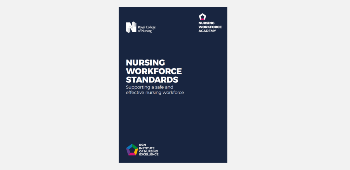Introduction

These standards apply across all settings in which nursing care is provided, and across the whole of the UK. The standards are designed to support a safe and effective nursing workforce alongside each nation’s legislation.
They are to be used by:
- those responsible for funding, planning, contracting, commissioning, designing and providing services which require a nursing workforce in any setting
- nurse leaders involved in workforce planning and setting nurse staffing establishments
- all members of executive/corporate boards who are accountable and responsible for ensuring the safety and effectiveness of nursing services
- employers responsible for improving the health, wellbeing and safety of the nursing workforce
- local, regional and national organisations seeking to effect positive change for the nursing workforce
- regulators of health and care services
- professional regulators, for example, the Nursing and Midwifery Council
- universities delivering courses for pre- and post-registration nursing students
- the nursing workforce to understand their rights and the support needed to deliver safe and effective care.
The standards are aligned to and may be used alongside the RCN Employment Standards for Independent Health and Social Care Sectors.
Key references to support the standards have been included for the first time.
Robust workforce planning is fundamental to the standards, although they do not define specific models or tools of nursing workforce planning. Nursing establishments should be set to ensure that nurse staffing can always exceed the critical minimum staffing levels (defined by registered nurse-to-patient ratio). Where there is established practice or setting specific guidance, this should be followed, and the nursing workforce standards are to be used alongside such guidance.
When setting establishments a 27% minimum uplift or headroom must be implemented to support safe and effective staffing during planned and unplanned absences.
The recommendation of 100% supervisory or supernumerary status for registered nurse leads such as ward, department or nursing home managers will promote strong, visible nursing leadership to support and supervise the delivery of high-quality nursing care for patients and service users.
The standards support continued professional development for the nursing workforce. They promote the emotional, psychological, mental, and physical health and wellbeing of all nursing staff. The nursing workforce should work in environments that are safe, just and inclusive, this must be a priority for all employers.
The nursing workforce as defined in this resource is intended to include registered nurses, and nursing support workers (including registered nursing associates). It does not include supernumerary students, volunteer staff or others such as housekeeping and clerical staff. Midwifery is not included as they have their own guidance.
The 14 workforce standards are grouped into 3 key themes:
Responsibility and accountability
These 4 standards outline where the responsibility and accountability lie within an organisation for setting, reviewing and taking decisions and action regarding the nursing workforce.
Clinical leadership and safety
These 6 standards outline the need for registered nurses with lead clinical professional responsibility for teams, their role in nursing workforce planning and the professional development of that workforce.
Health, safety and wellbeing
These 4 standards outline the health, safety, dignity, respect and inclusive values of the nursing workforce to enable them to provide the highest quality of care.
Executive level registered nurse
A registered nurse who has executive responsibility on the corporate board and is ordinarily responsible for assuring the board in nursing workforce issues. Executive level registered nurses have a pivotal and transformational role in an organisation. They navigate a complex set of stakeholders and partners in the service of organisational values and must use their influence at board level to guide nursing priorities for their organisation.
Designated senior registered nurse lead
A nurse leader in smaller organisations where there is no executive nurse who has authority to make decisions about setting nursing establishment. They will report directly to the responsible board or senior management team.
Registered nurse lead
Each clinical team or service that provides nursing care must have a registered nurse lead. This function may be fulfilled by registered nurses holding different titles, but the requirement of the role is set out in the descriptor for Standard 5.
Staffing for safe and effective care
Having the right number of registered nurses and nursing support workers with the right knowledge, skills and experience in the right place at the right time is critical to the delivery of safe and effective care for all those who use health and care services.
Nursing support workers
Support the registered nurse in the provision of nursing care. This term encompasses a wide range of roles and titles which may include registered nursing associates, assistant practitioners, health care assistants, health care support workers and nursing assistants.
Corporate board
The body with the ultimate governance responsibility for any organisation providing health and care services.
Patients/service users
In these standards, this refers to those who use or are affected by the services of professionals within the nursing workforce. This umbrella term also covers clients, residents, children, and other common terms.
Pre-registration nursing students
Any individual enrolled onto an NMC-approved education programme whether full-time or part-time. This also includes student nursing associates and student nurse apprentices.











